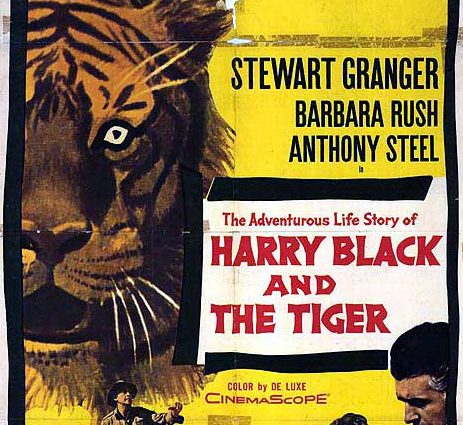(Ten years after independence in 1958 a classic Hollywood movie was shot in Mudumalai and Masinagudi areas with an English actor in the lead and three Indians in the cast. ‘Harry Black and the Tiger’ was based on a famous novel about a former British Army Major, Harry Black, coming to the rescue of an Indian village terrorized by a Bengal tiger. Stewart Granger, who was a favourite in Assembly Rooms, Ooty in the 1960s, was the hero. His earlier, another India based movie, Bhowani Junction with Ava Gardner was a great hit.
The movie met with mixed reviews but all were praise for the Nilgiri settings and the native cast.)
One reviewer said, “Those of us who are old enough to have seen that Stewart Granger film entitled Harry Black and the Tiger were treated to all the essential ingredients of a typical tiger-shoot in Anglo-India — blazing sun and tall grass, sunburned Englishman and his trusty rifle, the ‘native’ tracker and his mysterious intention and finally the great black-and-yellow beast leaping.”
Another wrote, “As a boy growing up in the 1950’s, I was totally fascinated by Great White Hunters and exotic locations such as Africa and India. Stewart Granger was also one of my favorite actors, so this movie quickly became one of my most well-liked. My son was a missionary in India, and he felt the same way. The landscape and wildlife photography is exquisite, and the movie does a fine job of showing the people of India and their culture in a non-prejudicial way. I particularly enjoyed the depiction of the relationship of Harry and his gun-bearer, Bapu (I.S. Johar), which appeared to be built on mutual respect and admiration in spite of the racial prejudice that I’m sure existed at the time between many of the British and the native peoples.”
But the New York Time reviewer was less impressed. He wrote, ‘Anyone expecting a rousing adventure yarn from such a title as Harry Black and the Tiger had better think twice before visiting the Paramount, where this Twentieth Century-Fox release opened yesterday’.
But he was much impressed with the Indian (Nilgiri) setting and the native cast. He added, ‘While both the cast and the scope of the action are comparatively small, the scenes at a remote outpost, with deep, natural panoramas and glimpses of native Indian life, enhance the Cinemascope screen in good color. Three native Indians, perhaps aptly, steal the picture right out from under the verbose British colonials. Frank Olegario and Kamala Devi do well briefly on the sidelines. But a chirpy, bright-eyed little man named I. S. Johar, as Mr. Granger’s faithful servant, has only to open his mouth to own the picture.”
Image: Poster of the movie
Nilgiri Documentation Centre

